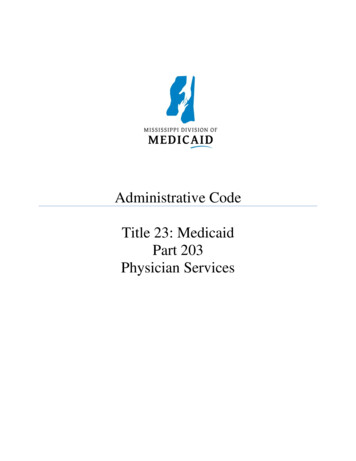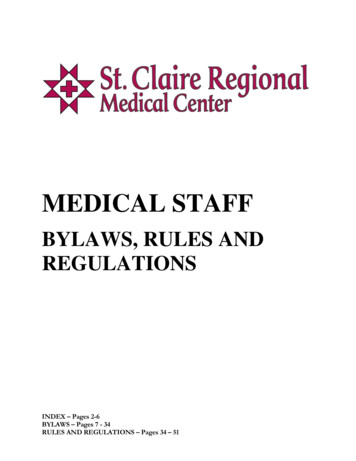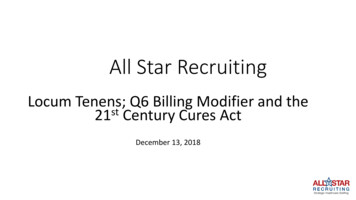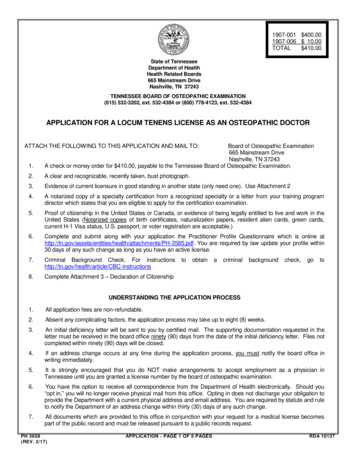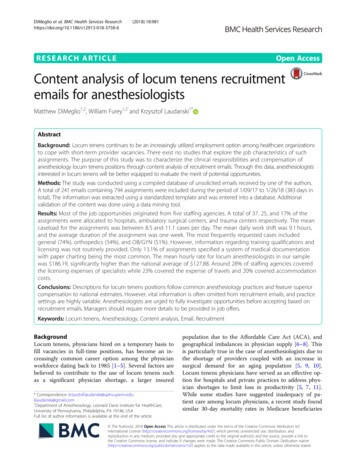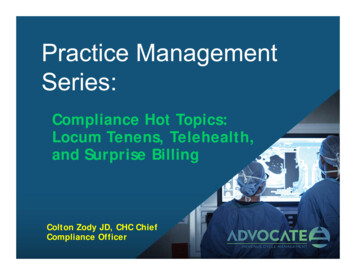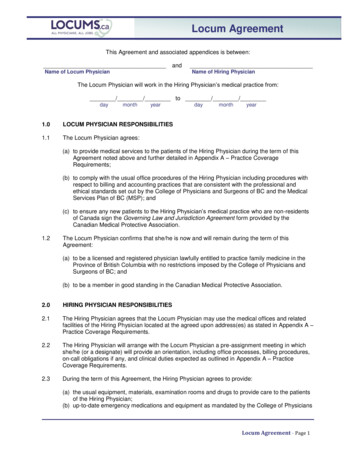
Transcription
Authors: M Slabbertand BH PienaarUSING A LOCUM TENENS IN A PRIVATE PRACTICEISSN 1727-37812013 VOLUME 16 No 4http://dx.doi.org/10.4314/pelj.v16i4.3
M SLABBERT AND BH PIENAARPER / PELJ 2013(16)4USING A LOCUM TENENS IN A PRIVATE PRACTICE M Slabbert*BH Pienaar**1IntroductionThe words locum tenens originate from Latin meaning "one holding a place".1 Thisphrase dates back to the middle ages when the Catholic Church provided clergy toparishes where there was no priest available. These travelling clergy were calledlocum tenens, placeholders for the churches they served. In later years thedesignation was used by doctors ("principals") who needed a person to temporarilyfill their positions, should they not be available for a short period of time. It was onlyduring the 1970s that the term was generally used by medical facilities where therewas a shortage of medical doctors.2 Originally the staffing shortages were largely insparsely populated areas, as high-income positions in large cities drew doctors awayfrom the rural communities. Today locum tenentes are in demand nearlyeverywhere, whether in a city or a small town, when a doctor is not personallyavailable to practice. Doctors in private practice may make use of a locum for severalreasons; to take study leave or acquire new skills, to attend foreign or localcongresses, or just for vacation leave.It is not always possible to fill these gaps internally and hence the need for locums.Most of the time locums are appointed by medical practitioners without thinking ofthe legal consequences of the appointment. In legal terms when something goeswrong either with a patient or with the practice, it is very important to establish ***12We are indebted to the anonymous peer reviewers for their valuable comments on an earlierdraft of this article.Magda Slabbert. BA Hons HED B Proc LLB LLD. Professor Department of Jurisprudence,University of South Africa. Email: slabbm@unisa.ac.za.Hendrik Pienaar. MBChB FRCS (Glasgow) ChM (UCT). Senior Specialist, Faculty of HealthSciences, University of Pretoria. Email: Hendrik.Pienaar@up.ac.za.Jaganathan 2008 Bulletin 2601.Applegate 2012 voices.yahoo.com.95 /487
M SLABBERT AND BH PIENAARPER / PELJ 2013(16)4whether a locum was appointed as an employee or as an independent contractor forthe period that he or she has to stand in for the principal.The focus of this article is only on medical practitioners in a private practice makinguse of a locum. The difference between an employee and an independent contractoris highlighted as well as the legal consequences following each type of appointment.If a locum is appointed as an employee, the rights of employees under the LabourRelations Act3 and the Basic Conditions of Employment Act4 could come into playdepending on the amount of remuneration the locum will receive. A further aspect totake cognisance of when appointing a locum as an employee is the possibleapplication of the doctrine of vicarious liability, according to which the medicalpractitioner himself or herself could be held liable for the unlawful and/or negligentconduct of the locum. This danger exists to a lesser extend if a locum is appointedas an independent contractor, as vicarious liability will be applicable only if thedoctorappointed an incompetent locum or where a locum's actions causedprejudice to third parties.5Two pro forma contracts that a medical practitioner in private practice appointing alocum himself or herself can use are included. These contracts are analysed andrecommendations are made to improve the current options to the benefit of bothparties. A medical practitioner can also make use of an agency or a temporaryemployment service to provide the practice with a locum for the period he or she willnot be available. The legal consequences in this regard are highlighted only to theextent that they overlap with the test of an employee-employer relationship, but ona different level.Neither of the two pro forma contracts addresses the effect of the ConsumerProtection Act6 on the medical profession. This aspect is discussed very briefly,3456Labour Relations Act 66 of 1995 (LRA).Basic Conditions of Employment Act 75 of 1997 (BCEA).See Chartaprops v Silberman 2009 30 ILJ 497 (SCA).Consumer Protection Act 68 of 2008.96 /487
M SLABBERT AND BH PIENAARPER / PELJ 2013(16)4mainly to indicate the role of the locum in the application of the Act in a medicalcontext and how it should be contractually addressed.2The Health Professions Act 56 of 1974The Health Professions Act does not address the appointment of a locum directly;neither does the Act indicate whether a locum should be appointed as an employeeor an independent contractor. Section 9 of the Ethical Rules of Conduct forPractitioners registered under the Health Professions Act, 1974 determines thefollowing regarding locums - without prescribing that the appointment of the locumshould either be as an employee or as an independent contractor:7A practitioner shall employ as a professional assistant or locum tenens, or inany other contractual capacity and, in the case of locum tenens for a period notexceeding six months, only a person –(a) who is registered under the Act to practise;(b) whose name currently appears on the register kept by the registrar interms of section 18 of the Act; and(c)who is not suspended from practising his or her profession.Section 18 of the same Rules states that:(1)(2)A practitioner shall accept a professional appointment or employmentfrom employers approved by council only in accordance with a writtencontract of appointment or employment which is drawn up on a basiswhich is in the interest of the public and the profession.A written contract of appointment or employment referred to in sub rule(1) shall be made available to the council at its request.The Ethical Rules to the Act thus determine that a locum cannot be appointed for aperiod exceeding six months.8 The locum should also be registered as a healthpractitioner with the Health Professions Council of South Africa (HPCSA) and thecontract of appointment should be in writing. If a member of the HPCSA would liketo see such a contract of appointment, it should be available. Thus, neither the Act78GN R717 in GG 29079 of 4 August 2006 as amended by GN R68 in GG 31825 of 2 February 2009and GN R654 in GG 33400 of 30 July 2010 (Ethical Rules of Conduct for Practitioners).See also McQuoid-Mason and Dada A-Z of Medical Law 259-260.97 /487
M SLABBERT AND BH PIENAARPER / PELJ 2013(16)4nor the Ethical Rules prescribes how a locum should be appointed; as an employeeor an independent contractor.It is up to the medical practitioner (principal) and the locum to determine thecontents of the contract of employment. The important reason to distinguishbetween an employee and an independent contractor is because the law attachesdifferent consequences to either appointment. If a locum is appointed as anemployee, labour legislation will be applicable to the contract of employment, whichwill not be the case where an independent contractor is involved.Case law addressing the appointment of a locum by a medical practitioner does notexist, but it is interesting to note that in the "Notice concerning the conditions ofemployment of dental technicians who are employees"9 section 1 describes a locumtenens as "an employee who is employed to relieve a regular employee or dentaltechnician contractor for any period during which a regular employee or dentaltechnician is absent, on sick or other leave".Disciplinary action by the HPCSA has been taken against some medical practitionerswho allowed unqualified or unregistered persons to act as locum tenens (whetherappointed as employees or independent contractors), resulting in hefty fines and/ortemporary suspension.10 Medical practitioners should accordingly also take carewhen appointing locums to ensure that they are duly qualified and registered.If no contract was concluded stipulating whether the locum is an employee or anindependent contractor, this complicates matters if a dispute arises. In such aninstance the courts will fall back on the reality test11 to determine the position of the91011BN 13 in GG 35015 of 7 February 2012 (Notice concerning the conditions of employment ofdental technicians who are employees).HPCSA Date Unknown www.hpcsa.co.za. What is interesting about the two cases adjudicated bythe HPCSA is that the first doctor was fined R20 000 for employing a locum while knowing thathe was not registered as a medical practitioner. The second doctor was fined R32 500 for issuingunprofessional medical certificates and the employment of a locum who was registered for publicservice only and not for private practice. These sanctions are quite severe if other transgressionsand their penalties are compared to it.Denel (Pty) Ltd v Gerber 2005 26 ILJ 1256 (LAC).98 /487
M SLABBERT AND BH PIENAARPER / PELJ 2013(16)4locum. The reality test is the test currently applied by the courts to determinewhether an employee or an independent contractor is involved in a dispute.Previously the courts relied on other common law tests but they proved to beinadequate over time.3Employee or independent contractor?3.1 Common lawThe common law views a contract of employment as an ordinary contract betweentwo parties. It further treats a service contract as a subdivision of a contract oflease. In Roman times there were three different contracts of lease namely:(a)(b)(c)locatio conductio rei (the lease of a thing);locatio conductio operarum (lease of work – the contract of employmentas we know it today); andlocatio conductio operis (the leasing of piece work – an independentcontractor today).12Common law defines a contract of employment as an agreement between twoparties in terms of which one of the parties (the employee) undertakes to place hisor her personal services at the disposal of the other party (the employer) for anindefinite or determined period, in return for a fixed or ascertainable remunerationand which entitles the employer to define the employee's duties and to control themanner in which the employee discharges them.13 A contract for a certain type ofwork for a specified time is defined as a reciprocal contract between an employerand an independent contractor.An individual contract of employment commences when the parties agree to theessential terms in the contract and the contract complies with the generalrequirements for a valid contract, namely: there must be consensus between theparties, both parties must have contractual capacity, the rights and duties stipulated1213Du Plessis, Fouche and Van Wyk Practical Guide to Labour Law 11.Grogan Workplace Law 29.99 /487
M SLABBERT AND BH PIENAARPER / PELJ 2013(16)4in the contract must be possible to perform, the rights created and duties assumedmust be permitted by law, and the formalities, if prescribed, must be adhered to.14There can be no legally binding relationship between the parties qua employer andemployee unless the parties have entered into a valid contract of employment.15It might not be clear whether the contract between the parties is an employeremployee contract or a contract between an employer and an independentcontractor. Because of the possibility of such confusion the courts have formulatedcertain tests in order to ascertain the real relationship between contractual parties.These tests are the control test, the organisational test, and the dominantimpression test. The control test was first formulated in the case of Colonial MutualLife Assurance Society Ltd v Macdonald16 in which Chief Justice De Villiers said: one thing appears to me beyond dispute and that is that the relation ofmaster and servant cannot exist where there is a total absence of the rightof supervising and controlling the workman under the contract; in otherwords, unless the master not only has the right to prescribe to theworkplace what work has to be done but also the manner in which suchwork has to be done.This test proved unsatisfactory over time and more tests were identified, like theorganisational test. According to this test one has to look at how integrated theperson is in the organisation. In SABC v McKenzie17 Myburgh JP said as follows:The second [test] is the organisational test: a person is an employee if he ispart and parcel of the organisation whereas the work of an independentcontractor, although done for the business, is not integrated into it but onlyaccessory to it.This test is vague as it is unclear how to determine the extent of integration. TheAppellate Division (as it was then known) rejected this test as being too vague. 181415161718Grogan Workplace Law 28-45.Borg-Warner SA (Pty) Ltd v National Automobile and Allied Worker's Union 1991 12 ILJ 549(LAC) 557 G-I.Colonial Mutual Life Assurance Society Ltd v Macdonald 1931 AD 412 434-435SABC v McKenzie 1999 1 BLLR 1 LAC.S v AMCA Services 1962 4 SA 537 (A).100 /487
M SLABBERT AND BH PIENAARPER / PELJ 2013(16)4The third test was the dominant impression test. This test relied on variousindications to determine whether there is an employer-employee relationship or not.In the case of the Medical Association of SA v Minister of Health19 Zondo AJ said:The dominant impression test it seems, entails that one should have regardto all those considerations or indicia which would contribute towards anindication whether the contract is that of service or a contract of work andreact to the impression one gets upon consideration of all such indicia Thisis still unsatisfactory as is the question of how one decides whether adismissal is fair or unfair and indeed, whether certain conduct is reasonableor unreasonable.All three tests have now been rejected by the Courts and are therefore not usedanymore. In their place the Labour Court has introduced the "realities test", which,while linked to the previous tests, takes a slightly different approach.3.2 The reality testThe reality test was first described in the case of Denel (Pty) Ltd v Gerber20 and hassince been expanded upon and confirmed in other cases.21If the contract between the medical practitioner and the locum stipulates that it is acontract of employment and the locum is therefore considered an employee of theprincipal, the reality test will not be necessary. It will be relevant only if there iseither no written contract (or the contract is unlawful in terms of the HPCSA rules)or where the parties dispute their relationship. As stated earlier it is important todetermine the basis of the relationship between a practitioner and locum as labourlaws apply only to employers and employees and not to an independent contractor.In order to understand the reality test it is necessary to refer to the Labour RelationsAct 66 of 1996 (LRA) and the Basic Conditions of Employment Act 55 of 1998 (BCEA)192021Medical Association of SA v Minister of Health 1997 5 BLLR 562 (LC) 569 F-GDenel (Pty) Ltd v Gerber 2005 26 ILJ 1256 (LAC).See State Information Technology Agency (Pty) Ltd v Commission for Conciliation, Mediation &Arbitration 2008 29 ILJ 2234 (LAC).101 /487
M SLABBERT AND BH PIENAARPER / PELJ 2013(16)4as well as the "Code of Good Practice: Who is an employee", Notice 1774 of 2006.22The Acts and the Code form the basis of the reality test (previously applied as thedominant impression test).3.2.1 Labour legislationThe LRA defines an employee in section 213 as:(a)(b)Any person, excluding an independent contractor, who works foranother person or for the state and who receives, or is entitledto receive any remuneration; andAny other person who in any manner assists in carrying on orconducting the business of an employer.The BCEA defines an employee in the same way.In 2002 amendments were made to the LRA and the BCEA by adding a provision toeach Act creating a rebuttable presumption as to whether a person is an employeeor not.23 In order to prove that a locum is an employee of the principal the applicant(either the doctor/locum/or third party as the case may be) must demonstrate that:(a)(b)the locum worked for or rendered services to the person cited inthe proceedings as their employer; andany one of the seven listed factors in the Acts is present in theirrelationship (principal and locum).The seven factors are:(a)(b)(c)(d)2223the manner in which the person works is subject to the controlor direction of another person;the persons hours of work are subject to the control or directionof another person;in the case of a person who works for an organisation, theperson forms part of the organisation;the person has worked for that other person for an average of atleast 40 hours per month over the last three months;Gen N 1774 of GG 29445 of 1 December 2006 (Code of Good Practice: Who is an employee).Section 200A of the LRA and s 83A of the BCEA; see also s 12 of the Code of Good Practice.102 /487
M SLABBERT AND BH PIENAAR(e)(f)(g)PER / PELJ 2013(16)4the person is economically dependent on the other person forwhom he or she works or renders services;the person is provided with tools of trade or work equipment bythe other person; orthe person only works for or renders services to one person.It is important that the principal and the locum appointed by him or her should beclear whether the locum is appointed as an employee or as an independentcontractor. They should also comply with whichever two of the options they havechosen, in order to avoid the application of the reality test from being applied,24 asthe presumption referred to above applies, regardless of the form of the contract. Inother words, merely stating that a locum is not an employee or is an independentcontractor is not conclusive proof of the status of the locum.25The fact that a locum satisfies only one of the seven factors does not establish thathe or she is in fact an employee. However, the onus then falls on the principal as theemployer to lead evidence to prove that the locum is not an employee but in actualfact an independent contractor. This is important, as will be indicated when vicariousliability is discussed.Cognisance should also be taken of the fact that section 200A of the LRA and section83A of the BCEA apply only to employees earning less than the threshold determinedfrom time to time by the Minister of Labour in terms of section 6(3) of the BCEA.The threshold amount is currently R183 008-00 per annum.26 This means that alocum earning approximately R15 500-00 per month will not have all the rights anordinary employee has under the BCEA or the LRA.If a locum is appointed as an independent contractor, labour legislation does notapply at all, and the doctrine of vicarious liability becomes applicable only if anincompetent locum is appointed or, as stated earlier, the locum acts in such a way242526For an application of the reality test, see Denel (Pty) Ltd v Gerber 2005 26 ILJ 1256 (LAC).See alsoss 16 and 17 of the Code of Good Practice.GN R429 in GG 35404 of 1 June 2012 (Determination of earnings threshold).103 /487
M SLABBERT AND BH PIENAARPER / PELJ 2013(16)4as to cause prejudice to third parties.27 The locum as an independent contractor ishired solely to provide physician services as a substitute physician for a limitedperiod of time. Whilst assigned office hours may exist, such physicians (independentcontractors) exercise their own professional judgement in treating patients.28 A trulyindependent contractor: will be a registered provisional taxpayer; will work his or her own hours; runs his or her own business; will be free to carry out work for more than one employer at the same time; will invoice the employer each month for his or her services and be paidaccordingly; will not be subject to usual "employment" matters such as the deduction ofPAYE or UIF from his or her invoice, will not receive a car allowance, annualleave, sick leave, a 13th cheque etc.294Vicarious liabilityVicarious liability is a doctrine of liability without fault, meaning one person is heldliable to a third party for the unlawful act of another.30 In the context of anemployment relationship, the employer can be held liable for the unlawful acts of anemployee – or the doctor who employs a locum as an employee can be held liablefor the unlawful or unprofessional acts of the locum. This is contrary to the generalprinciple that there can be no liability without fault. Calitz31 quotes Flemming, whoargues that the doctrine is based on policy considerations, the most important ofwhich is "the belief that a person who employs others to advance his own economicinterest should in fairness be placed under a corresponding liability for losses2728293031As Lord Bridge observed in D & F Estates Ltd v Church Commissioners for England 1989 AC 177208: "[I]t is trite law that the employer of an independent contractor is, in general not liable forthe negligent or other torts committed by the contractor in the course of the execution of thework".Russel and Thornton 2010 Proc (Bayl Univ Med Cent) 315.Israelstam Date Unknown www.labourguide.co.za (1).Calitz 2005 TSAR 215.Calitz 2005 TSAR 215.104 /487
M SLABBERT AND BH PIENAARPER / PELJ 2013(16)4incurred in the course of the enterprise".32 This is, in other words, a form of strictliability.33 The requirements for an employer's vicarious liability are as follows:(a)(b)(c)(d)there must be an employment relationship;the employee must have acted unlawfully;the act must have led to a third person suffering damages; andthe act must have taken place within the scope and course ofemployment.34The requirement that creates the biggest problem is the last - that the employeemust have acted within the scope of employment.Courts in Canada, the United Kingdom and Australia have moved away from a strictinterpretation and applied a "close connection" test in order to get more clarity onwhat "scope of employment" entails.35This trend was followed by the Constitutional Court in South Africa in the case of NKv Minister of Safety and Security 2005 26 ILJ 1205 (CC). In this case theConstitutional Court held that the common law doctrine of vicarious liability shouldbe developed to reflect the spirit, purport and objectives of the Constitution.36 TheCourt further contended that it is not merely a factual matter of whether a certainact falls within the scope of employment, as this would isolate the common law rulesfrom the pervasive normative influence of the Constitution.37 The Court furtheradded that there is also a countervailing principle, namely that "damages should notbe borne by employers in all circumstances, but only in those circumstances in whichit is fair to require them to do so".38The Court deduced that there must be a sufficient link between the acts of theemployee and the business of the employer even if the employee does something in32333435363738Calitz 2005 TSAR 215.Manamela 2004 SA Merc Law 125.Neethling, Potgieter and Visser Law of Delict 373. See also McQuoid-Mason and Dada A-Z ofMedical Law 433-434.Calitz 2007 Stell LR 451.The Constitution of the Republic of South Africa, 1996.NK v Minister of Safety and Security 2005 26 ILJ 1205 (CC) para 22 (the NK case).NK case para 21.105 /487
M SLABBERT AND BH PIENAARPER / PELJ 2013(16)4his or her own interest. The Court reasoned that this connection contained twoelements, namely a factual as well as a legal question, resulting in a mix of fact andlaw.39The above mentioned case illustrates issues that are worthy of cognisance regardingthe relationship between a principal and a locum. In other words the closeconnection test that was formulated in the case of NK could also be appliedconcerning the liability of a doctor for the acts of a locum if the locum was appointedas an employee. The court in the NK case stated that each case must be consideredindependently and it should be established whether a constitutional right had beeninfringed; if so the employer would be liable. But the court went further to state thateven in cases where no constitutional rights have been violated but the boni moresof society have been damaged, an employer may be held liable. Calitz 40 observedthe following concerning the NK case:While it is laudable that the Court did away with a test that is purely factualand acknowledged that it is in the end a policy decision of whether theemployer should be held liable, the guidance given how to decide the matteris confusing.41It thus seems a much safer option for a medical practitioner to appoint a locum at alltimes as an independent contractor and never as an employee. If the locum isappointed as an employee, the medical practitioner who hired or employed thelocum may very well be liable for any improper acts or omissions by the locum.394041NK case para 45.Calitz 2007 Stell LR 462.Calitz 2007 Stell LR 462.106 /487
M SLABBERT AND BH PIENAARPER / PELJ 2013(16)4Examples of contracts for locums425There is no prescribed form or specific contract for the appointment of a locum thatis regulated by the HPCSA, but a person can practise as a locum only if he or she isregistered in the category "independent practice" in terms of the Health ProfessionsAct.43 The following example is a contract for the appointment of a locum, which isavailable on the website of the South African Medical Association (SAMA) (emphasisadded).44AGREEMENT MEDICAL PRACTITIONER & LOCUM TENENSDr. (full name)(hereinafter referred to as "The Doctor")Of practice address)(hereinafter referred to as "The Practice")andDr. (full name)(hereinafter referred to as "The Locum")Of (practice or other address)1. I, the undersigned, a registered*medical practitioner/ specialist (registration number )am registered in the following profession (GP, Specialist- )2.Iundertaketoworkatthepracticeasfromandincluding .3. I will be practising full time at the practice daily between andweekends between and thereafter on call.4. *I understand that I will work as an employee of the doctor and will notrender the doctor, his partners/ associates or the practice liable for any of myactions whatsoever, arising from my involvement with the practice.OR424344See also Strauss Doctor, Patient and the Law 79-81 for guidelines for the appointment of alocum.Moyo E-mail.SAMA Date Unknown www.samedical.org.107 /487
M SLABBERT AND BH PIENAARPER / PELJ 2013(16)4* I understand that I will work as an independent contractor, and as such willpay the doctor the amount of R being the rental forpremises and the use of equipment, for the time I work as a locum in the practice.5. I am a member of the Medical Protection Society holding full cover for privatework and confirm that I will be held individually liable for any legal claims emanatingfrom my actions as a locum during the said period.6. *I will receive as remuneration the amount of Rpayable monthly/weekly/ daily until termination of the contract. I understand thatwith tax (PAYE) deduction, the final amount will be R andthis will be the full and final settlement of remuneration under this contract.ORThe amount of R will be payable to me by the doctor forprofessional services rendered by me, and being an independent contractor, Iundertake to pay income tax as necessary.7. I undertake not to practise medicine within a radius of km of thepractice for months/years after termination of the contract, except in thecapacity of a locum tenens for another practice.8. I shall do no remunerative work outside the practice while this contract is inexistence unless the doctor/s has/have consented in writing thereto.9. I undertake not to disclose any information regarding the patients or the practice.10. Furthermore, I undertake to leave the consulting rooms and accommodation, ifprovided, in the same condition in which I found it at the beginning of my term aslocum tenens.11. I have disclosed to the practice all material information regarding my registrationas a medical professional, my competence and field of practice, including anyimpairment as provided in section 51 of the Health Professionals Act of 1974.12. Should this agreement be cancelled by either of the parties, not within areasonable period of time, the defaulting party can be held liable by the other partyfor the payment of an amount of R500, 00.I choose as my domicilium citandi et executandi the above mentioned address.108 /487
M SLABBERT AND BH PIENAARPER / PELJ 2013(16)4This duly signed at on the day of 20DoctorLocum tenensWitness 1Witness 1Witness 2Witness 2* Delete where applicable.Section 1 to 3 of the SAMA contract above pose no problem as the locum has toindicate if he or she is registered with the HPCSA, and the period for which theappointment will be valid is stipulated: it may not be for more than six months. Inclause 4 there is a choice between being appointed as an employee or anindependent contractor, but what was said earlier concerning the realities testshould be remembered, in that the parties cannot just choose an option and leave itat that. They should make sure that they will pass the realities test should it benecessary to determine the real relationship between the parties. If the hatthedoctor,hispartners/associates or the practice will not be liable for any actions of the locumwhatsoever arising from his or her involvement with the practice. This is meant tocover the doctor against being held vicariously liable, as discussed above, yet it isdoubtful that a person can purport to waive the rights of third parties to sue theemploying doctor on the basis of vicarious liability in this way. It is recommendedthat the employing doctor should actually take out insurance to cover his or herliabili
The words locum tenens originate from Latin meaning "one holding a place".1 This phrase dates back to the middle ages when the Catholic Church provided clergy to parishes where there was no priest available. These travelling clergy were called locum tenens, placeholders for the churches they served. In later years the designation was used by doctors ("principals") who needed a person to .

